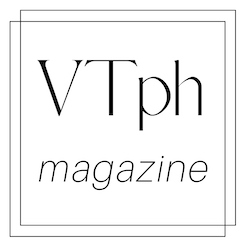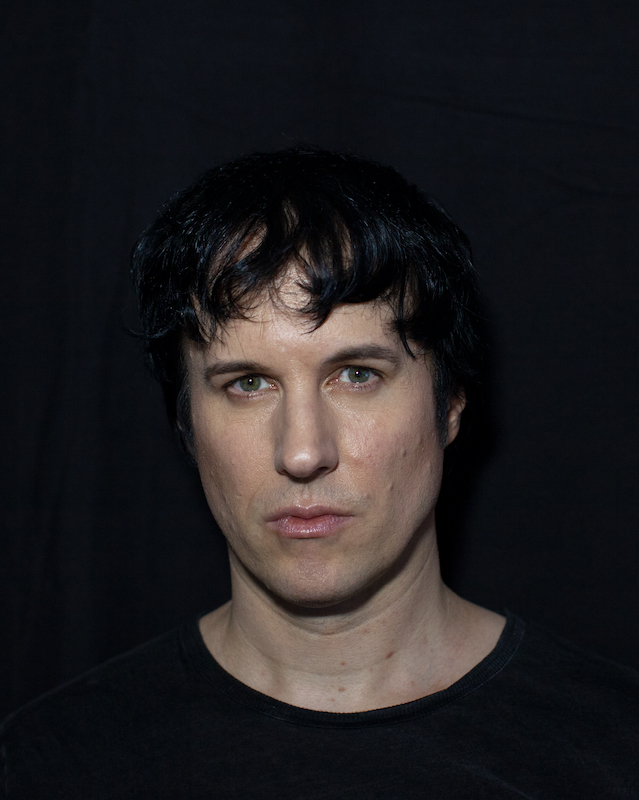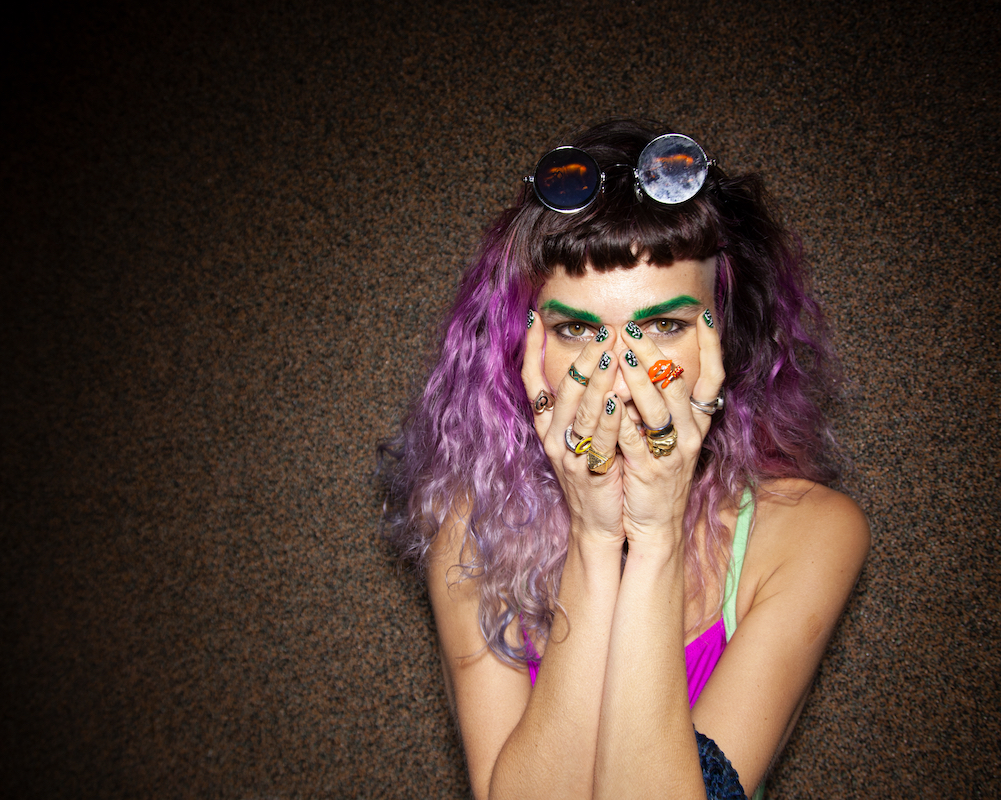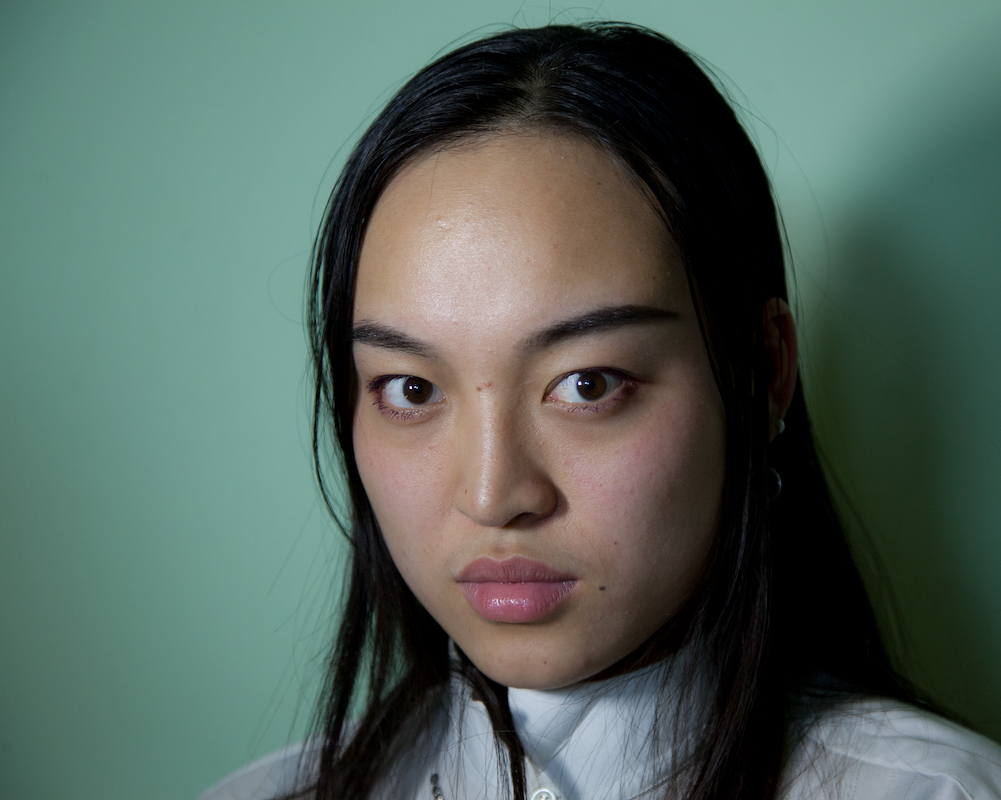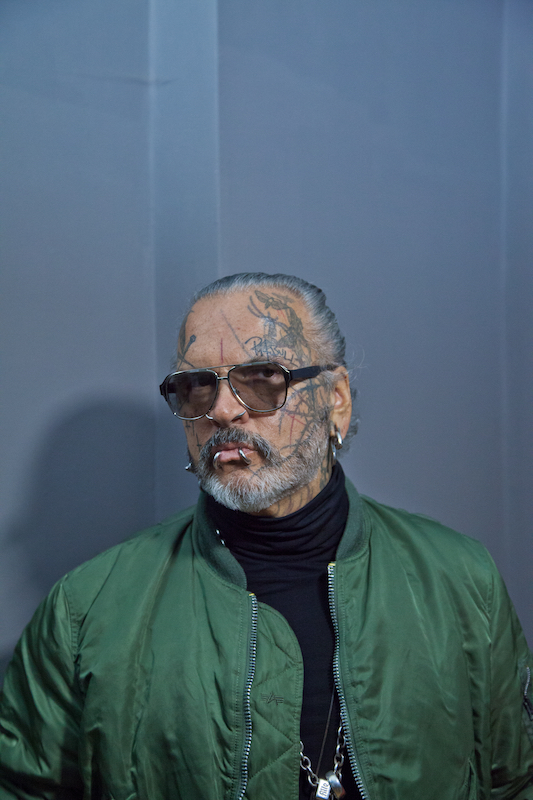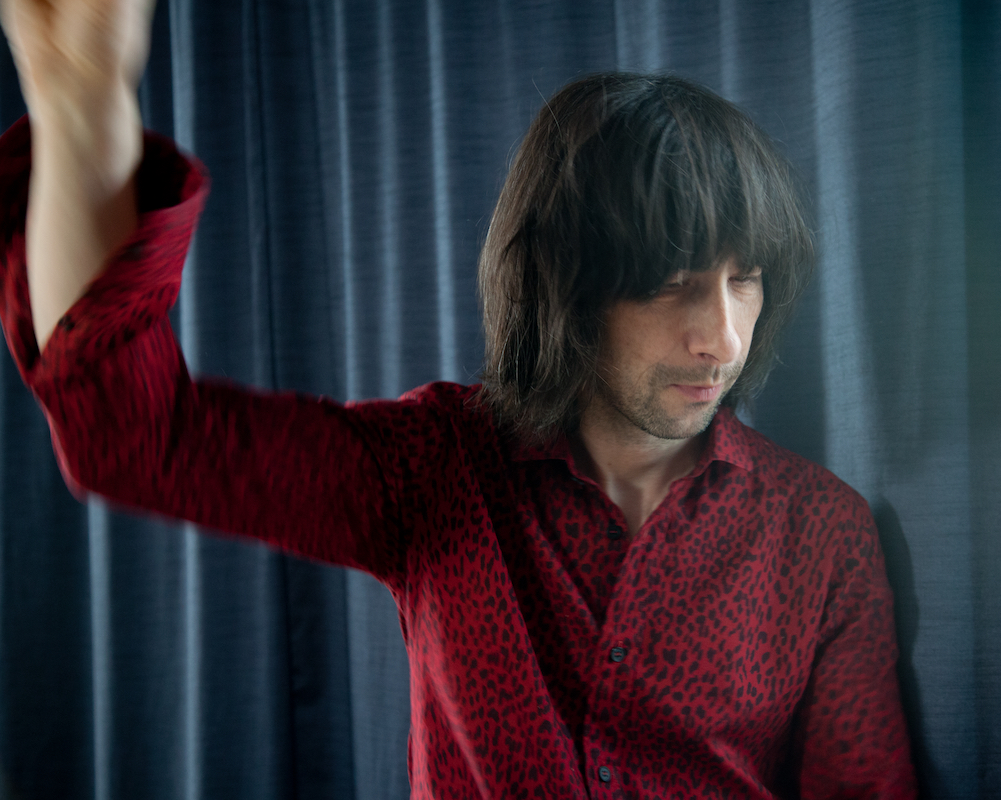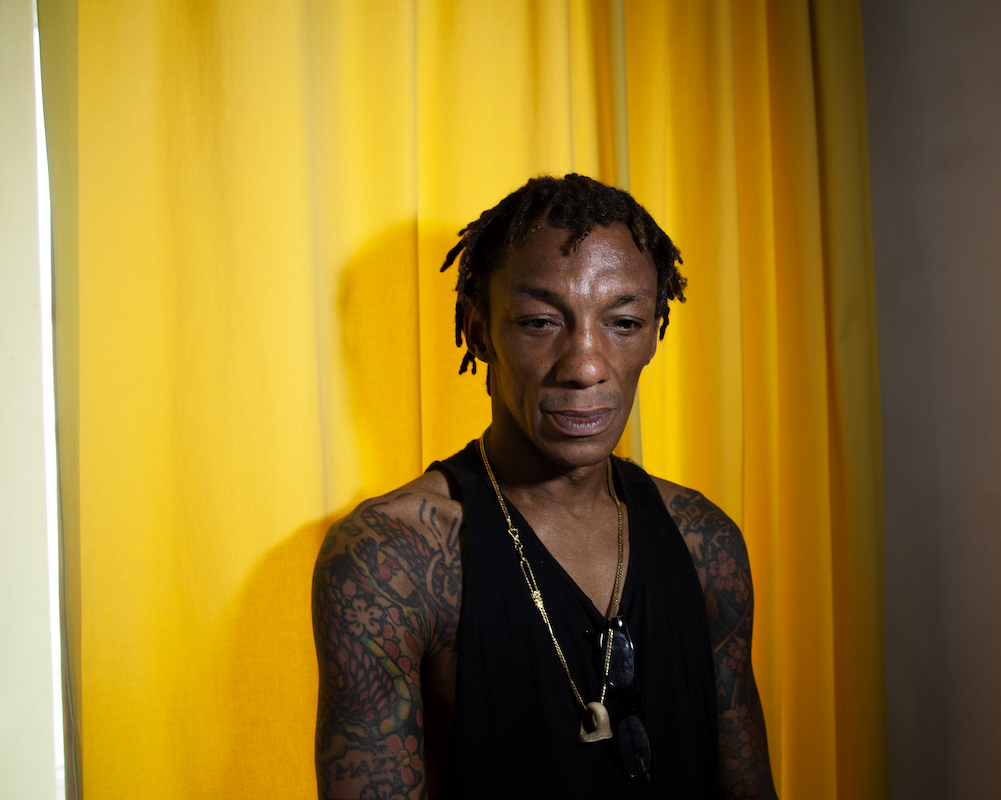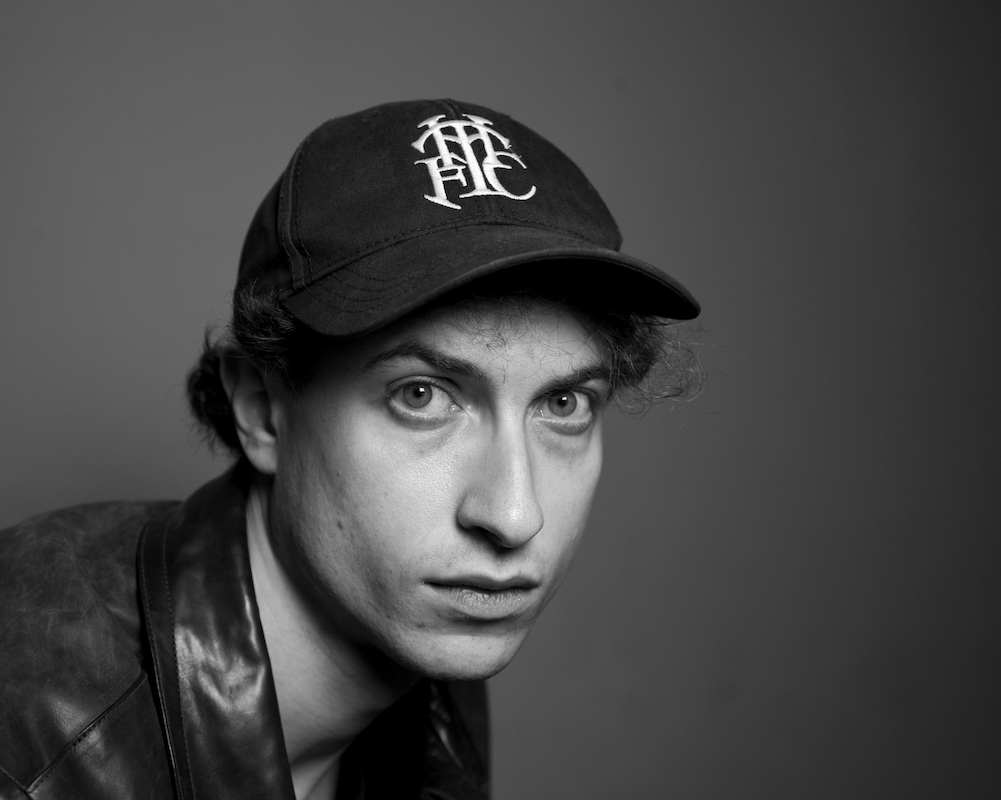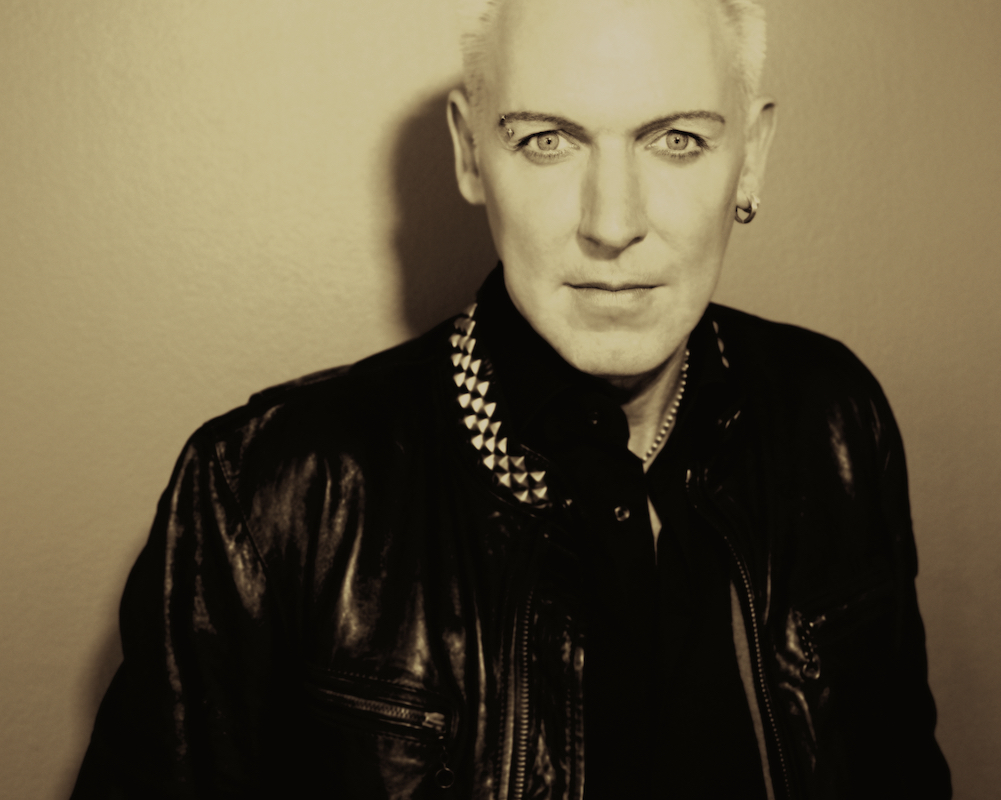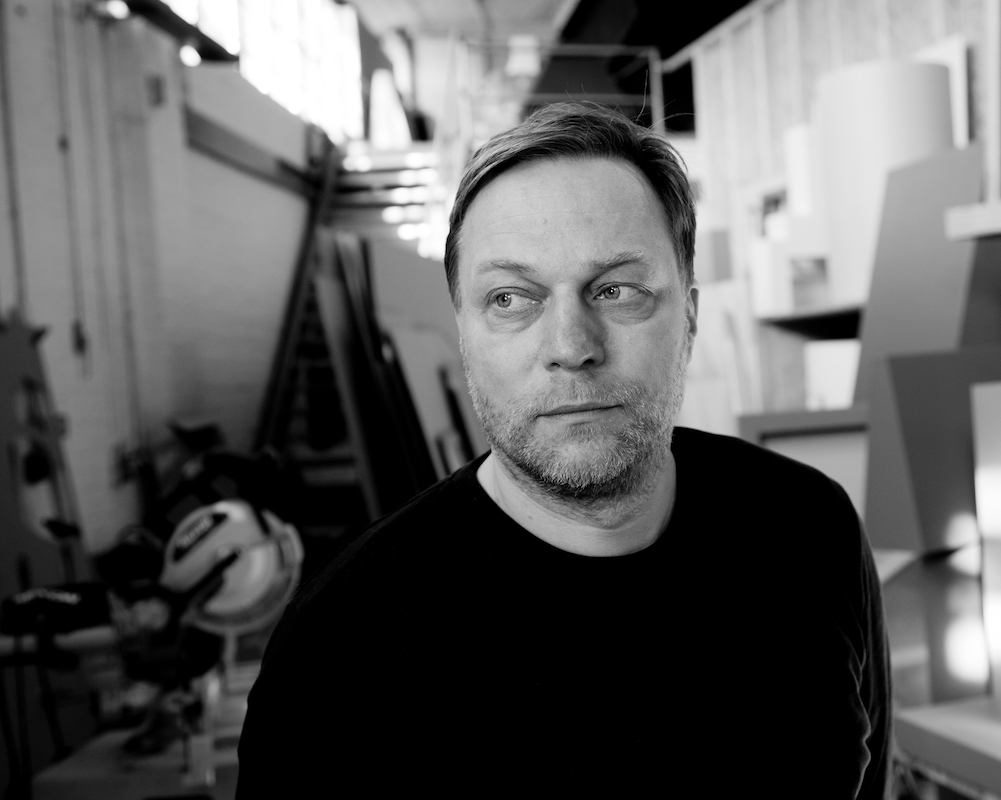Luci Lux
Max Dax: Luci Lux, als Filmemacherin hast du unter deinem bürgerlichen Namen Lucia Margarita Bauer mit »Snake in the Jar« und »Maman Maman Maman« zuletzt zwei preisgekrönte Kurzfilme veröffentlicht und arbeitest derzeit an einem dritten – du porträtierst in diesen Filmen Mitglieder deiner Familie. Als Fotografin machst du unter dem Namen Luci Lux Porträts berühmter bildender Künstler und Musiker. Wie sehr unterscheiden sich die Disziplinen, dass du sogar unter verschiedenen Namen arbeitest?
Luci Lux: Ich habe zunächst nur unter meinem Künstlernamen Luci Lux gearbeitet. Als ich aber bemerkte, in was für eine persönliche Richtung sich meine Filmarbeit entwickelte, habe ich mich dazu entschlossen, meinen echten Namen zu verwenden. Und obwohl ich in dem einen Medium filme und in dem anderen fotografiere, interessiert mich immer der Mensch, der hinter dem Gesicht steht. Gesichter sind einfach immer spannend. Ob das nun meine Eltern sind oder ob das eine fremde Person ist, die ich porträtiere. Oft entdecke ich erst in der Betrachtung der Bilder am Bildschirm etwas, das ich im Moment, als ich auf den Auslöser drückte, noch nicht gesehen habe. Ich lerne meine Gegenüber also gewissermaßen erst am Bildschirm näher kennen.
Wie hat man sich das vorzustellen? Schließlich manipulierst oder retuschierst du deine Bilder ja kaum.
Ich zoome rein in die Bilder. Ich sehe dann in die Augen der von mir Porträtierten. Mir fallen auch immer wieder Details auf. Da entdecke ich eine Narbe, oder ich bemerke, ob die Ohren groß oder klein sind. Vor allem begreife ich, in welchem Winkel ein Gesicht toll aussieht – und in welchem weniger. Es gibt Gesichter, die sehen aus jedem Winkel gut aus. Und es gibt andere Gesichter, die sehen im wirklichen Leben unglaublich interessant aus – und es ist dann sehr schwer, diesen Eindruck in einem Bild zu bannen. Ich lerne da auch nicht aus. Immer wieder bin ich überrascht, wie gut bestimmte Menschen, die im echten Leben unscheinbar wirken, auf dem Foto eine unglaubliche Präsenz haben – und umgekehrt. Mein Auge legt mich immer wieder rein. Im Umkehrschluss könnte man sagen: Weil ich weiß, dass das, was ich sehe, nicht von der Kamera so gesehen wird, lerne ich permanent dazu. Ein Film oder eine SD-Karte mit Fotodateien ist für mich immer wieder wie eine Black Box mit unbekanntem Inhalt.
Suchst du nach dem perfekten Winkel?
Ich versuche, meine Gegenüber immer gut aussehen zu lassen. Oft wandere ich einmal um sie herum, um Bilder aus möglichst vielen Perspektiven zu bekommen. Ich suche nach dem fotogenen Winkel. Aber mein eigentliches Ansinnen ist, eine Art Scan der Person zu machen.
In dem »objektivierenden« Sinne, wie eine Kamera auf Licht, Raum und Oberflächen reagiert?
Ich weiß nicht, ob das nur die Kamera sehen kann. Es gibt ja die These, dass man als Fotograf im Idealfall »sehen kann wie eine Kamera«, dass dieses »Sehen können, wie eine Kamera sieht« also eine Art Qualität ist, die man als Fotograf haben kann. Ich kann es auf alle Fälle nicht, daher muss ich mich jedes Mal aufs Neue einem Gesicht nähern. Mit der Kamera.
Ich kenne das von Alexander Kluge. Wer ihm einmal persönlich begegnet ist, wird bestätigen, dass es nur ganz wenige Bilder von ihm gibt, die wirklich »aussehen« wie er. Als ob hier die Maschine, die Kamera, überlistet werden muss. Tatsächlich schaffst du es aber in deinen Porträts, dass die Menschen ganz ohne Posen, natürlich rüberkommen.
Ich lerne diesen Blick vielleicht, aber wenn, dann nur, weil ich eben viel porträtiere, weil ich viel auf Menschen blicke, die Menschen beobachte. Das koppelt dann zurück auf Kameraeinstellungen – und zwar sowohl im Film wie auch in der Fotografie. Schon als Kind habe ich ständig Menschen, ständig Gesichter beobachtet. Bis heute könnte ich den ganzen Tag irgendwo sitzen und auf Gesichter blicken, die Leute beobachten und mir überlegen, wo sie herkommen und was sie machen. Was ist mit denen passiert? Warum sind sie so geworden, wie sie sind?
Interessant. Das sind Fragen, die ich mir als Interviewer ja ebenfalls permanent stelle. In Gesprächssituationen versuche ich übrigens, meinem Gegenüber immer in die Augen zu schauen, eine Art permanenten Augenkontakt zu halten.
Den Augenkontakt gibt es ja ebenfalls, aber oft geht es in den Porträts umgekehrt gerade darum, nicht in die Kamera zu schauen. Das freilich liegt zu einem Großteil in der Entscheidung der oder des Porträtierten. Ich gebe ja keine Anweisungen. Ich sage nicht: »Schau jetzt bitte an der Kamera vorbei, als ob es mich nicht gäbe.«
„Es ist oft nur eine Spannung im Gesicht, die abfallen muss, damit ein Blick mit einem Mal einen Einblick in die Seele zu vermitteln vermag. Man bildet es sich vielleicht nur ein, aber man erkennt einen solchen offenen Blick stets sofort. Und solche Bilder gelingen immer wieder.“–Luci Lux
Im filmischen Porträt hast du eine Zeitachse. Du kannst eine Person durch Bewegtbild, durch Dialoge und Schnitte porträtieren. Im Foto wird eine Millisekunde, ein Moment, eingefroren. Worin siehst du die Unterschiede zwischen den Medien?
Aus einem Foto kann ich nichts herausschneiden. Ich kann bestenfalls den Ausschnitt verändern, was einem Porträt einen wahnsinnigen Power-Schub geben kann. Im Film kann ich hingegen alles herausschneiden, was nicht stimmig ist und durch den Schnitt eine Dynamik erzeugen. In der Fotografie gibt es kein Auffangnetz. Ein Foto sitzt, oder es sitzt nicht. Das hat mit Illusion zu tun und mit der Art und Weise, wie man selbst die Dinge sieht. Das ist eben kein schulisch abgesicherter Blick, sondern ich muss mir immer wieder aufs Neue selbst vertrauen. Ich gehe deshalb übrigens auch selten selbstsicher in eine Porträtsituation. Ich bin immer nervös und immer unsicher. Das akzeptiere ich aber an mir.
Ich erinnere mich an unsere erste professionelle Begegnung. Ich hatte Joseph Kosuth in Rom in seiner Bürowohnung auf der Tiberinsel interviewt – »dieselbe Wohnung, in der vor mir Marlon Brando gelebt hat« –, und du solltest ihn anschließend fotografieren. Mir war völlig klar: Weil du permanent mit Filmquadrage zu tun hast, bist du folgerichtig auch eine super Fotografin.
Tatsächlich habe ich, obwohl ich Filme drehe, zuvor nie professionell fotografiert. Ich habe zwar immer fotografiert – aber für mich, als Notizen. Und die Session mit Kosuth ging um ein Haar schief. Erst in der Analyse der Bilder, und ein paar tolle waren ja trotzdem dabei, begriff ich, dass ein Porträt, das zum Beispiel ein Interview in einem Magazin illustrieren soll, wenig Raum für filmische Freiheiten bereit hält. Ein fotografisches Porträt muss aufrichtig sein, und das geht oft über den Blick. Ich blicke meinem Gegenüber in die Augen und sehe hoffentlich Aufrichtigkeit. Deshalb müssen die Augen immer scharf sein. Das klingt im Rückblick so einfach, aber bei mir war es der Beginn einer Reihe von immer aneinander interessierten Begegnungen, bei denen Fotos entstanden.
Du fotografierst oft Stars. Schwingt da vielleicht auch mal Anbetung mit?
Nein, das ist es nicht. Es ist eher so, dass ich Ikonen liebe – also, die Ikonenbilder aus der russisch-orthodoxen Kirche. Für jeden Tag gibt es einen Geistlichen oder Heiligen, dem eine Ikone gewidmet ist. Man kann sich also meditativ jeden Tag einem anderen Gesicht widmen. In der Regel sind dies die Gesichter von Menschen, die laut der Heiligen Schrift Wunder vollbracht haben sollen. Andrej Tarkowskij hat einen ganzen Film über Andrej Rublev gedreht, den größten Ikonenmaler aller Zeiten. Der Film ist lang, langsam erzählt und in Schwarz-Weiß gedreht. Erst in der Schlussszene wird die Leinwand in strahlende Farbigkeit getaucht, wenn die Kamera eine Ikone von Andrej Rublev abfährt. Stars sind oft Menschen, die im direkten Umgang völlig unkompliziert sind, kommunikativ und auch körpersprachlich größtes Selbstbewusstsein ausstrahlen. Ich bin dann nie verwundert, dass sie Stars sind, die von den Menschen wie moderne Heilige verehrt werden, wenn sie doch bereits im kleinen Raum eine solche Aura haben. Ich versuche daher immer den Menschen zu sehen, der in diese Rolle hinein gewachsen ist oder geworfen wurde.
Es gab bei dir immer wieder Phasen, in denen du täglich porträtiert hast. Mit journalistischem Auftrag, aber mit eigenem Stil. Wie wichtig war dieser intensive Rhythmus?
Sehr wichtig. Ich hatte eine Zeit lang eine Session nach der anderen, oft mehrere an einem Tag. Dass sich die Situationen wie Rituale wiederholten, machte mich entspannter und entspannter. Und das haben, glaube ich, auch meine Gegenüber immer gespürt.
Warst du denn bei Joseph Kosuth nicht entspannt?
Ich fühlte mich nicht sicher. Ich kannte das nicht, unbekannterweise vor jemanden zu treten und diesen aus nächster Nähe zu fotografieren, ihn auch dirigieren zu dürfen. Die Unsicherheit wich aber in der Folge der wiederkehrenden Freude, einer Person wirklich näher kommen zu können, ohne ihr oder ihm auf die Pelle zu rücken. Joseph Kosuth hat meine Unsicherheit und meine Scheu übrigens sofort bemerkt. Er reagierte sehr empathisch, als ob ich seine Tochter wäre. Das hat die Situation dann im Guten aufgelöst.
Viele deiner Porträts waren Auftragsarbeiten von Magazinen. Inwiefern ist das dann für dich journalistische oder Gebrauchsfotografie? Oder ist es umgekehrt so, dass du gewissermaßen »embedded« in einen Auftrag, eben gerade künstlerisch arbeiten kannst?
Im Film setzt du Hintergrund, Schauspieler und Licht. Bei einer Fotosession hast du den Raum und das Licht, das dir zur Verfügung steht. Und du hast zumeist eine sehr kleine Zeitspanne, oft nur wenige Minuten, um dein Bild zu machen. Du musst ganz schnell sein in deinem Kopf, du musst den Raum scannen, kuratieren, koordinieren und somit das Bild kreieren. Natürlich ist das auch ein künstlerischer Akt.
In deinen beiden Filmen hast du dich sehr moderner Erzählmethoden bedient. Mich erinnern deine Filme an den späten Godard und an die Filme von Chris Marker. Der Porträtfotografie stehen im Vergleich weniger Werkzeuge zur Verfügung, um zum Beispiel »modern« zu sein. Um das Medium auszureizen.
Das stimmt schon. Aber das Besondere liegt nicht in der Frage der Modernität, sondern darin, dass ich stets versuche, eine Geschichte liebevoll zu erzählen. Ob im Film oder in der kurzen Begegnung einer Fotosession. Man kann die Empathie, Zuneigung oder Sympathie, die mir entgegengebracht wird, im Foto dann sehen. Und wenn dies passiert, dann zeigt sich in dem Gesicht mit einem Mal ganz viel. Wenn jemand mit Vertrauen zu dir blickt, ist das stärker als jede Pose. Ganz klar ist: Ich möchte nichts stellen, ich möchte im Film wie im Foto die Dinge so klar und so liebevoll zu zeigen, wie es geht. Insofern gibt es tatsächlich Parallelen zwischen dem Film und der Fotografie. Und oft komme ich dadurch auf eine persönliche Ebene. Ich komme in einen ganz persönlichen Moment rein. Ich habe dann oft das Gefühl, dass sich mein Gesicht in den Gesichtern meiner Gegenüber widerspiegelt. Eine Situation, in der ein Porträt entstehen soll, ist schließlich ein ganz intimer Moment. Offen und direkt, und nie geht es darum, jemanden bloßzustellen. Und zum Bloßstellen gehört für mich bereits, wenn ich meinem Gegenüber sage, was er oder sie zu tun hat. Also sage ich am liebsten gar nichts. Manche fühlen sich einen Moment irritiert, aber eigentlich bleibe ich immer dabei, dass ich nichts fordere. Sie müssen sich selbst entscheiden, wie sie stehen wollen, wie sie gucken. Und diese Unbeholfenheit wandelt sich im Foto oft in einen sehr persönlichen, offenen Ausdruck. Und dieser Blick, diese Körperhaltung ist dann die Schönheit im Antlitz.
Weil die Körperspannung nicht abgerufen, nicht gestellt ist?
Ja, genau. Ein Porträt einer Person, die für einen Moment nicht weiß, was sie tun soll, hat dann im besten Fall etwas Reines. Denn sie wird ja mit liebevollem Blick betrachtet.
Ist es wirklich nur das Schweigen, das dieses Vertrauen in der kurzen Zeit aufzubauen vermag?
Ich bin aber auch schüchtern in dem Moment. Und im besten Fall spüre ich gegenseitige Sympathie. Und die ganz kurzen Sessions sind meist die Stars, also diejenigen, die sehr berühmt sind. Sie sind es gewohnt, zu posen. Sie wissen bereits ganz genau, wie sie gucken werden.
Und ist das nicht kontraproduktiv?
Ich fand es im Gegenteil immer total bewundernswert, wenn einer weiß, wie er sich zur Kamera verhalten muss. Das führt dann zunächst dazu, dass mir stets erst einmal das gleiche Gesicht, der gleiche Blick angeboten wird – wie schon Tausenden vor mir. Ich weiß zugleich aber gar nicht, ob ich das wirklich durchbrechen will. Denn ich will nichts vorgeben. Und manchmal gibt es ja auch Zufälle.
Und das Schweigen mag solche Zufälle ja vielleicht auch provozieren.
Es ist oft nur eine Spannung im Gesicht, die abfallen muss, damit ein Blick mit einem Mal einen Einblick in die Seele zu vermitteln vermag. Man bildet es sich vielleicht nur ein, aber man erkennt einen solchen offenen Blick stets sofort. Und solche Bilder gelingen immer wieder. Meist ist es völlig klar ein einzelner Frame, der aus einer Serie von Bildern, die alle den vermeintlich gleichen Gesichtsausdruck zeigen, heraussticht. Irgendetwas ist in diesem Moment anders. Und die Kamera hat diese Millisekunde eingefangen.
In der Galerie Santa Lucia stellst du zum ersten Mal selbst aus. In einer Gemeinschaftsausstellung mit Caroline von Grone. Sie malt Porträts, und mit Daniel Blumberg gibt es einen Künstler, den ihr beide porträtiert habt. Er musste für Caroline von Grone Stunden, wenn nicht sogar Tage posieren. Er erbat sich einen Tisch, Papier und Stifte, so dass er die Zeit, während er im Stehen porträtiert wurde, damit verbringen konnte, eine Zeichnung nach der anderen anzufertigen. Du hingegen machst eine Session mit Daniel Blumberg, und nach zehn Minuten seid ihr fertig. Ihr hättet sogar mehr Zeit gehabt.
Ich beneide Caroline in diesem Sinne, und ich bewundere es, wie sie es von Angesicht zu Angesicht hinbekommt, ohne Zuhilfenahme von Dia-Projektionen oder Fotos, ein Abbild zu schaffen. Ich kenne viele der Menschen, die sie gemalt hat. Und die sehen wirklich so aus. Ihre Bilder sind nicht gestellt. Ich finde das total bewundernswert. Ich finde es auch toll, dass jemand so toll malen kann, das Handwerk an und für sich so beherrscht. Und über allem steht, dass sie die Seele ihrer Gegenüber einzufangen scheint in ihren Bildern. Mit den Farben, mit dem Licht … sehr bewundernswert.
Es geht also um den Blick in die Seele?
Es geht vermutlich eher darum, sich in der Kürze der Zeit kennenzulernen.
Hast du das Gefühl, Typen wie Tricky oder Dave Gahan in diesem Sinne besser kennengelernt zu haben?
Ich meinte eben tatsächlich Caroline, wenn sie Daniel Blumberg über einen Zeitraum von zwei Tagen porträtiert. Dann hat sie ja wirklich die Chance, den Menschen, der hinter seinem öffentlichen Bild steht, kennenzulernen. Und das bleibt mir ja ganz oft verwehrt. Ich lerne die Leute dann eher im Anschluss, in der Sichtung der Bilder am Bildschirm, kennen. Wenn ich in ihre Augen reinzoome, Frame für Frame. Meine Leinwand ist der Bildschirm.
Aber wie sehr greifst du in deine Bilder dann ein?
Ich korrigiere die Farben und den Kontrast. Und ich wähle einen Ausschnitt. Ich entferne Schuppen von dunklen Pullovern. Und das war’s bereits. Der Eingriff ist besteht in der Sorgfalt, mit der das eine von 50 ähnlichen Motiven schließlich ausgewählt wird.
Was passiert mit den restlichen 49 Bildern?
Ich schmeiße die nicht weg. Und dann passiert es, dass ich mir die Session mit Tricky ein Jahrzehnt später noch einmal durchschaue, und ich begegne einem Bild, auf dem sich Tricky für einen Moment refokussiert. Er schaut mit gesenktem Blick gen Boden, und sein Körper entspannt. Das hatte ich vor neun Jahren, als das Bild entstand, wohl nicht als geeignetes Motiv empfunden. Heute kann ich meine damalige Wahl nicht mehr nachvollziehen. Es war etwas mehr von seinen Augen zu sehen, das Bild weniger dark. Das zeigt nicht zuletzt, wie sich der eigene Blick auch im Laufe der Jahre ändert. Aber das geht vermutlich vielen so. Man verändert sich. ~
Max Dax: Luci, as a filmmaker you have released two award-winning short films under your real name Lucia Margarita Bauer – »Snake in the Jar« and »Maman Maman Maman«. And currently you are working on your third film. In these films you portray members of your family. As a photographer, you make portraits of famous visual artists and musicians under your artist name Luci Lux. How different are the disciplines that you release your work under different names?
Luci Lux: I initially worked only under my artist name Luci Lux. But when I noticed what a personal direction my film work was taking, I decided to use my real name instead. And although I film in one medium and photograph in the other, I’m always interested in the person behind the face. Faces are just always exciting. Often, it’s only when I’m looking at the images on my computer screen that I discover something that I hadn’t seen at the moment I pressed the shutter release. So in a way, I get closer to my subjects in the post production.
But you hardly ever manipulate or retouch your images …
That’s true. But I always zoom deep into the images to get closer to the eyes of the person I’ve photographed. In doing this I always notice details. I discover a scar, or I notice whether the ears are big or small. Above all, I gradually understand at which angle a face looks great. Some people look great from every camera angle while others could look incredibly interesting in real life – and yet it’s very hard to capture that impression in a photo. Time and again, I’m surprised at how certain people who look unremarkable in real life can develop an incredible presence in a photograph. My eye fools me constantly. I know that what I see isn’t seen that way by the camera. In that sense, I’m constantly learning. A film or an SD card with photo files is always like a black box with unknown contents for me.
Are you looking for the perfect angle?
I always try to make my subjects look good. I often wander around them to get pictures from as many perspectives as possible. I look for the photogenic angle. But my real intention is to make a kind of scan of the person.
In the »objectifying« sense of how a camera reacts to light, space and surfaces?
I don’t know if only the camera can see that. There is, after all, the thesis that as a photographer you can ideally »see like a camera«, that this »being able to see like a camera sees« is therefore a kind of quality that you can have as a photographer. I certainly don’t have that ability, so I have to approach a face anew every time with the camera.
I know this from Alexander Kluge. Anyone who has ever met him in person will confirm that there are very few pictures of him that really »look« like him. As if the machine, the camera, has to be outwitted. But in your portraits people come across naturally, without any poses.
I do a lot of portraits. I look a lot at people, observe people. That then links back to camera angles – both in film and in photography. When I was a child, I was constantly watching at people and their faces. To this day, I could sit somewhere all day and look at them and think about where they come from and what they are doing. What happened to them? Why did they become the way they are?
Interesting. These are questions that I, as an interviewer, also ask myself all the time. In conversation situations, by the way, I always try to look my counterpart in the eye, to maintain a kind of permanent eye contact.
There is also eye contact, but in portraits it is often a matter of not looking into the camera. Of course, this is largely the decision of the person portrayed. I don’t give any instructions. I don’t say, »Please look past the camera now, as if I wasn’t there.«
„It’s often just a tension in the face that has to relax, so that a glance is suddenly able to provide an insight into the soul. You may only imagine it, but you always recognize such an open look immediately. And such pictures succeed again and again.“–Luci Lux
In cinematic portraiture, you have a timeline. You can portray a person through moving image, through dialogue and editing. In the photograph, a split-second, a moment, is frozen. What do you see as the differences between the media?
I can’t cut anything out of a photo. At best, I can change the cropping, which can, in fact, give a portrait an incredible power boost. In film, on the other hand, I can cut out anything that’s not coherent and create a dynamic through the editing. In photography, there’s no catch-all. A photograph is great – or it isn’t. It has something to do with illusion and the way you see things with your own eyes. It’s not a view that’s secured by academic schooling; I have to trust myself over and over again. That’s why, by the way, I rarely go into a portrait session confident. I’m always nervous and insecure. But I accept that about myself.
I remember our first professional encounter. I had interviewed Joseph Kosuth in Rome in his office apartment on Tiber Island – »the same apartment where Marlon Brando lived before me« – and you were supposed to photograph him afterwards. It was absolutely clear to me that since you’e permanently involved in films, you’re also a great photographer.
Actually, although I shoot films, I have never photographed professionally before. I’ve always taken pictures – but for myself, as visual notes. And the session with Kosuth almost went wrong. It wasn’t until I checked the images – and there were a few great shots anyway – that I realized that a portrait intended to illustrate an interview in a magazine has little room for cinematic freedom. A photographic portrait has to follow certain rules and ratios. And the eyes always have to be in focus.
You often photograph celebrities. Is there also worship involved?
No, it’s not that. It’s more that I love icons – that is, the medieval icon paintings from the Russian Orthodox Church. For every day there is a saint to whom an icon is dedicated. So, meditatively, you can devote yourself to a different face each day. As a rule, these are the faces of people who, according to the Holy Scriptures, are said to have performed miracles. Andrey Tarkovsky made a whole film about Andrei Rublev, the greatest icon painter of all time. The film is long, slowly narrated and shot in black and white. Only in the final scene is the screen bathed in brilliant color, when the camera passes over an icon of Andrei Rublev. I experienced that stars are often completely uncomplicated in direct contact, they are communicative and also exude the greatest self-confidence via their body language. I am rarely ever surprised that they are revered like modern saints, if they already have such an aura in a small room. So I always try to see the person behind the celebrity who has grown into or has been thrown into this role.
You went through phases in which you’d portray people almost on a daily basis. With a journalistic assignment, but persuing your own style. How important was this intensive rhythm?
Very important. For a while I had one session after another, sometimes several in one day. The fact that the situations repeated themselves like rituals made me more relaxed and at ease. And I think my counterparts always felt that, too.
Didn’t you feel relaxed with Joseph Kosuth?
I didn’t feel safe. I didn’t know what it was like to step in front of someone and photograph them at close range, to be even allowed to conduct them. But the insecurity subsequently gave way to the recurring joy of being able to really get closer to a person without getting in his or her way. Joseph Kosuth, by the way, noticed my insecurity and shyness immediately. He reacted very empathetically, as if I were his daughter. That then resolved the situation for the better.
Many of your portraits were commissioned by magazines. To what extent is that journalistic or commercial photography for you? Or is it the other way around, that you are »embedded« in a commission, so to speak, and can just work artistically?
In film, you set the background, actors and lighting. In a photo session, you can’t alter the space and the light. And you usually only have a very small time span, often only a few minutes, to take your picture. You have to be really quick in your mind, you have to scan the space, curate it, coordinate it, and thus create the image. Of course, this is also an artistic act.
In both of your films you’ve developed very modern narrative methods. Your films remind me of the late films of Godard and the films of Chris Marker. Portrait photography, in comparison, has fewer tools at its disposal to be »modern,« to push the medium to the limit.
That’s true. But what makes it special is not a question of modernity, but the fact that I always try to lovingly tell a story – be it in a film or in the brief encounter of a photo session. One can see the empathy, affection or sympathy that is shown to me in the photo then. And when this happens, suddenly a lot becomes visible in a face. When someone looks at you with confidence, that’s stronger than any pose. It is very clear: I don’t want the person I portray to pose for me. I want to show him or her as clearly and as lovingly as I can. In this respect, there are indeed parallels between film and photography. And often I get into a very personal moment. I then often have the feeling that my face is reflected in the faces of the person I am photographing. A situation in which a portrait is to be created is, after all, a very intimate moment. Open and direct, and it’s never about exposing anyone. And for me, embarrassment already includes telling my subject what he or she has to do. So I prefer to say nothing at all. Some feel irritated for a moment, but actually I always stick to not demanding anything. They have to decide for themselves how they want to stand, and where they look. And this awkwardness often turns into a very personal, open expression in the photo. And this look, this posture is then the beauty in the face.
Because the body tension is not called up?
Yes, exactly. A portrait of a person who, for a moment, doesn’t know what to do then, in the best case, has something pure. After all, he or she is being looked at with a loving gaze.
Is it really only silence that can build up this trust in such a short time?
But I’m also shy at that moment. And in the best case, I feel mutual sympathy. And the very short sessions are usually the stars, those who are very famous. They don’t have time, but they are experienced in being photographed. They already know exactly how they’re going to look. So they pose without me telling them to pose.
And, isn’t that counterproductive?
On the contrary! I’ve always found it totally admirable when someone knows how to behave towards the camera. The first thing that happens is that I’m unsually offered the same face, the same look – just like thousands of others before me. At the same time, however, I don’t know whether I really want to break this pattern. Because I don’t want to pretend anything. And sometimes of course coincidences are happening.
And the silence may perhaps also provoke such coincidences.
It’s often just a tension in the face that has to relax, so that a glance is suddenly able to provide an insight into the soul. You may only imagine it, but you always recognize such an open look immediately. And such pictures succeed again and again. Most of the time, it is clearly a single frame that stands out from a series of images that all show the supposedly same facial expression. But on one of the frames something is different at that moment. And the camera has captured this split-second.
In the Santa Lucia Gallery you are exhibiting for the first time photographs of your own – in a joint exhibition with paintress Caroline von Grone. She paints portraits in oil, and there’s an artist, Daniel Blumberg, who you both portrayed. He had to pose for Caroline von Grone for hours, if not days. Eventually he requested a table, paper and pencils so that while he was being portrayed standing up, he could spend the time making drawing after drawing. You, on the other hand, do a session with Daniel Blumberg, and after ten minutes you’re done. You would have had even more time.
I envy Caroline in that sense, and I admire how she manages to create a likeness in a face-to-face situation, without the aid of slide projections or photographs. I know many of the people she has painted. And they really look like that. Her paintings are not staged. I think that’s totally admirable. I also think it’s great that she can paint so extraordinarily and that she has such mastery of the craft in herself. And above all, she seems to capture the soul of her subjects in her paintings. With the colors, with the light … very admirable.
So it’s about the view into the soul?
It’s probably more about getting to know each other in the short time.
Do you feel like you’ve gotten to know guys like Tricky or Dave Gahan better in that sense?
I was actually referring to Caroline when she portrays Daniel Blumberg over a two-day period. Then she really has the chance to get to know the person behind his public image. And that’s something I’m often denied. I only get to know the people that I’ve portrayed afterwards, when I’m looking at the pictures on the screen. When I zoom into their eyes, frame by frame. My canvas is the screen.
But how much do you intervene in your images?
I correct the colors and the contrast. And I choose a crop. I remove dandruff from dark sweaters. And that’s it. The intervention is in the care with which the one of 50 similar motifs is finally selected.
What happens to the remaining 49 images?
I don’t throw them away. And then it happens that I look back through my session with Tricky a decade later, and I come across a picture in which Tricky refocuses for a moment. He is looking down at the ground with his eyes lowered, and his body is relaxing. Nine years ago, when the picture was taken, I seem not to have felt that this was a suitable motif. Today, I can no longer understand my choice at the time. This shows not least how one’s own view also changes over the years. But that probably happens to many people. One changes. ~
Interview: Max Dax, May 2022
© all images by Luci Lux / Exhibition: Situation 76, Luci Lux & Caroline von Grone »Portraits«, Opening: May 25, 2022, Exhibition: May 26 – July 30, 2022 (by apointment only), Galerie Santa Lucia, Lübbener Straße 22, D–10997 Berlin
